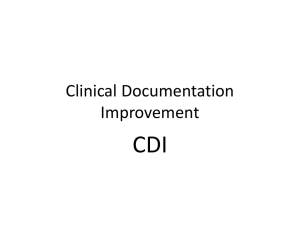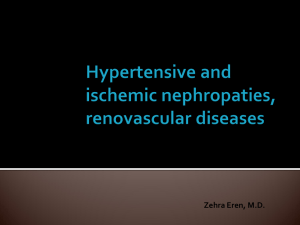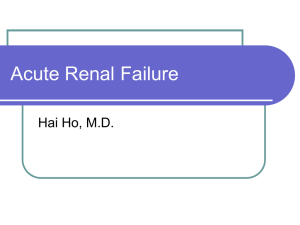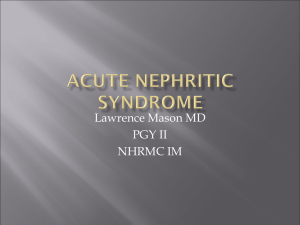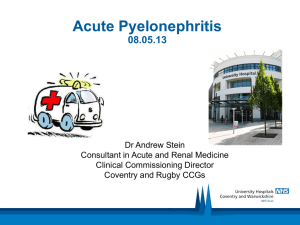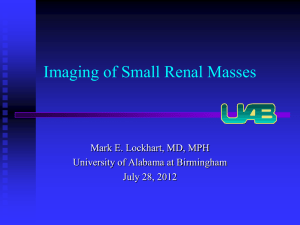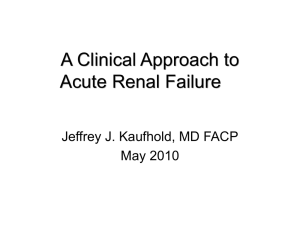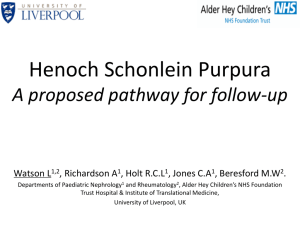wegener`s granulomatosis (ppt / 4322 kb)
advertisement
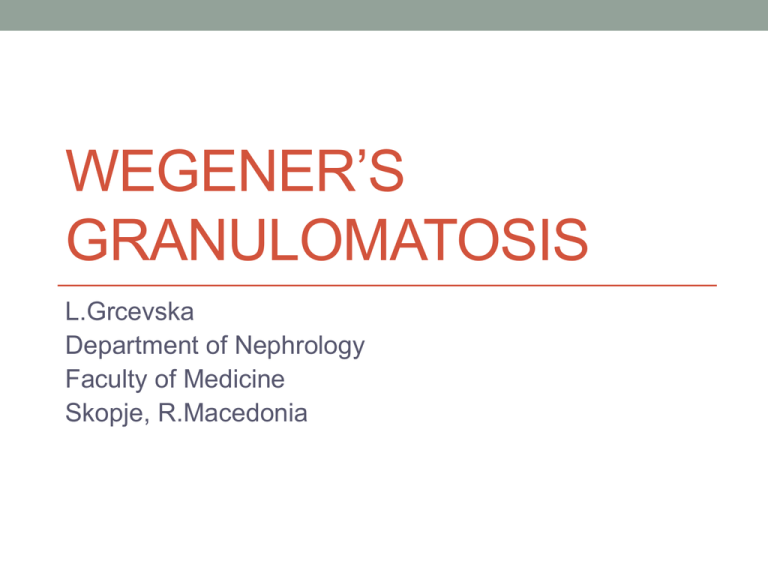
WEGENER’S GRANULOMATOSIS L.Grcevska Department of Nephrology Faculty of Medicine Skopje, R.Macedonia Case 1 (typical presentation) • Male patient, 58 year-old • Extra-renal clinical features at presentation: - fever - arthralgia - weakness - cough - dyspnea - hemoptysis • Duration of the symptoms prior to admission: 2 weeks Case presentation • Renal symptoms: oligoanuria, 4 days prior to admission • Serum urea levels at admission: 56 mmol/l • Serum urea creatinine: 939 µmol/l • Plasma protein level: 58g/l • Hb 101g/l, RBC count 3.200 000, WBC count 11000 • Ultrasound revealed enlarged, edematous kidneys • Hemodialysis treatment started immediately Possibilities • Acute renal failure associated with infection? • Acute glomerulonephritis associated with infection? • Rapidly progressive glomerulonephritis? • Acute tubulo-interstitial nephritis? • Vasculitis? Which form? • Other systemic disorders? Case presentation • Chest X-ray examination performed during the second day revealed pulmonary granulomata • ANCA 328 • Anti-DNA negative • The diagnosis of Wegener’s granulomatosis was confirmed Renal biopsy • RB was performed during the first week of admission and it reveals necrotizing glomerulonephritis with crescents. • 6/12 glomeruli were completely destroyed, the other 6 presented partial necrosis. 10/12 glomeruli presented crescents • Interstitial granulomata were also present • IMF was negative Case presentation • We presented a typical case with WG, distinguished as a clinical entity by Friedrich Wegener in 1936. The first well explained cases were described between 1947 and 1958 as “an illness characterized by symptoms of progressive ulceration in the respiratory tract together with signs of widespread inflammatory disease, histological examination of material from each shows disseminated granulomata, most common in the respiratory tract and kidneys and wide spread vascular lesions similar to polyarteritis nodosa …” • It is now clear that WG is a rare disease characterized by disseminated granulomatous vasculitis which primarily affects upper and lower respiratory tract and the kidneys. • Systemic clinical features (fever, fatigue, arthralgia) similar to those present in viral infections can also be found • Antineutrophil cytoplasmic autoantibodies directed against various components of the neutrophil cytoplasm are now regarded as a serological marker for renal-limited necrotizing and crescentic glomerulonephritis or associated with systemic vasculitis such as WG or other vasculitides • The diagnosis is difficult Why? • The disease is rare, 3 – 14 per million in European countries in 2009 • The epidemiology of WG is largely unknown, and it seems that the disease is more frequent in northern countries • The course of the disease may vary, form weeks to months • Various organ involvement may be noted: - esophageal, colonic, hepatic granulomata - pancreatic, thyroid, cardiac, salivary glands, ocular, otologic and bone involvement may be present • Affection of the upper and lower respiratory tract is more common in the patients from northern countries and affection of the gastrointestinal tract in ones from southern countries • “Non-renal” WG is known in the literature • Renal involvement in literatures varies from <20% to 80%, but invariably increases to 80-94% during follow-up in the same studies • So, does the “non-renal” form exist? Our patients with WG • Number of detected patients: 28, biopsied 18 • Male/female ratio • • • • 2:1 Age 19 – 68 , 48,61+-13,79 (M+-SD) Extrarenal clinical features prior to admission: fever, sinusitis, cough, hemoptysis, weight loss, arthralgia, otitis, laringeal pain, gastrointestinal bleeding, various combinations of the symptoms Renal symptoms: renal failure in all patients serum creatinine 265 – 1704), oligoanuria in 38,9% Proteinuria in non-oliguric patients 0,17 – 5,15 g/d (only two patients were nephrotic) Our experience – other cases with WG • Duration of extra-renal clinical features prior to admission: one week – one year, sometimes with relapsing course • Extra-renal features noted in the other patients: sinusitis, necrosis of the adipose tissue of legs, weight loss, extensive gastrointestinal bleeding, granuloma of adipose tissue of legs, granulomatous inflammation of skin with necrosis (histology), granulomatous inflammation detected in biopsies of the gastrointestinal system (gastric and colonic granulomata) • Diffuse proliferative glomerulonephritis with crescents on biopsy or necrotizing glomerulonephritis Treatment of our patient • Plasmapheresis • Cyclophosphamide i.v. • Steroids i.v, continuing orally • Outcome of the disease: - diuresis occurred after 3 weeks - there was complete recovery of the pulmonary involvement - renal function improved to serum creatinine of 147 µmol/l after 3 months - the patient presented slow deterioration of the renal function during further 3 years (ESRD) Case 2 – difficult diagnosis • 36-year old male patient, diagnosed 2009 • 4 years prior to admission relapsing cutaneous bullous • • • • changes in axillar and inguinal regions, TBC excluded 6 months prior to admission dysphonia, laringeal papilloma was ablated – histological diagnosis suggested viral etiology Two weeks later – fever, with relapsing course 5 months prior to admission 4 months prior to admission – cough, hemoptysis, two inpatient treatments in his town-hospital 2 months prior to admission - arthralgia Case 2 • Admission at Department of Pulmology on 18th of December 2009. Because of development of anuria and serum creatinine 450 µmol/l he was transferred to our Department • Diagnosis (Dep.Pulm): Infiltratio pulmonum. Status febrilis. Sepsis. Acute renal failure. Acne inversa s. Hydradermitis suppurativa (dermatologist) • (Dep.Nephr)Granuloma were detected along GIT (gaster, esophagus, colon, cecum) • Renal biopsy: Glomerulonephritis extracapillaris proliferativa, 2/10 glomeruli revealed partial sclerosis, disruption of Bowman’s membrane with granulomatous answer was noted in one of the glomeruli. Granulomatous infiltration of the interstitium was also present. Case 2 – two years later • Relapsing otologic and laringeal problems • There is no pulmonary involvement • There is no joint and skin involvement • Granuloma od the esophagus are still present, without bleeding • Serum urea levels 9,7 – 12 mmol/l, serum creatinine 104 – 113 µmol/l, daily urine out-put is normal • Proteinuria 0,9 – 1,2 g/daily Course of the disease • The disease in WG runs a rapidly progressive course • • • • • which usually leads to death within a few months (sometimes within weeks or days) unless treated with immunosuppressive therapy The disease is with relapsing course Prior to introduction of dialysis, uremia was the main cause of death Using cyclophosphamide and steroids , 5-year survival rate: 60-90% 20-60% of patients with renal involvement at start, developed ESRD within 5 years Andrassy and co-workers found that 29% developed ESRD (short-term follow-up) Treatment • Plasma exchanges • Steroids • Cyclophosphamide, azathioprine • MMF • Anti-adhesion molecule therapy • Monoclonal antibody therapy • Immuno-adsorbtion Outcome of the patients diagnosed at Department of Nephrology • Death because of respiratory failure (rare) – 2 cases • Death because of gastrointestinal bleeding (only one case) • Complete remission of pulmonary involvement (most frequent) • Partial remission of pulmonary involvement (only one case) • Relapsing pulmonary disease (rare)- only two cases, after 2 • • • • and 9 years One forth of the patients did not recover renal function during the admission Complete remission (renal+pulmonal) rare (only 3 cases) Persistence of stable renal failure with slow progression (most frequent) Probability surviving rate after one month 0,6111, 3 months 0,3889 (Kaplan-Meier) Conclusions – WG in R.Macedonia • The disease is rare, we diagnosed only 28 cases for the • • • • • past two decades Various organ involvement was noted with obligatory pulmonary affection Pulmonary involvement is with good prognosis Renal involvement reveal crescentic necrotizing or diffuse proliferative GN Relapsing course of the disease described in the literature is rare in R.M. Slow deterioration of the renal function is dominant renal clinical feature
